Nicola Pisano (died ca. 1284)
Nicola Pisano, who was born in Apulia, probably trained in the local workshops of the Emperor Frederick II, whose coronation he attended in Rome in 1220. He subsequently moved to Tuscany, arriving in Pisa in ca. 1245. It was here that his son Giovanni was born.
Nicola Pisano signed the pulpit (1255-60) in the baptistery of Pisa as "Nicola Pisanus", suggesting that he had citizenship there. This work is perhaps his masterpiece. He also executed the pulpit (1265–8) for the Duomo, Siena. Arnolfo di Cambio worked on both projects, and Giovanni Pisano also worked on the second one. Nicola and Giovanni Pisani then worked on the Fontana Maggiore in Perugia (see below).
Giovanni Pisano (died ca. 1315)
Giovanni Pisano executed the statues (1277–1284) in the two rows of traceried gables on the exterior of the baptistry of Pisa. After the death of his father in ca. 1284, he moved to Siena. He was appointed as capomaestro of work on the Duomo there in 1287-96. (In 1288, Ramo di Paganello and a number of his brothers and nephews were assigned to carry out some “good, beautiful and noble” works in the Duomo, on the condition that they did not interfere with the work of Giovanni Pisano and that they followed his instructions).
Giovanni Pisano then returned to Pisa: his work on the new pulpit (1302-10) of the Duomo, there is his masterpiece. His last major work was the monument (ca. 1313 ) to Margaret of Brabant, which was commissioned by her husband, the Emperor Henry VII, for San Francesco di Castelletto, Genoa.
Perugia
Fontana Maggiore (1277-8)
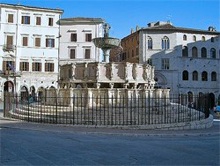
The Commune first began to plan the construction of a new aqueduct to bring water to the Perugia from Montepacciano in 1254. The work made little headway until 1277, when a commission of enquiry advised that it should be executed by the Venetian hydraulic engineer, Boninsegna, who had experience of a similar project at Orvieto. The Commune accepted this advice, and simultaneously sought the permission of the Prior General of the Sylvestrine Order for the appointment of Fra Bevignate as “superstans fontis et operis conductus” (supervisor of the work on the fountain in Piazza Grande , that was to be fed by the aqueduct). He seems to have been extraordinarily effective, because the work on what became known as the Fontana Maggiore was completed in 1278.
In 1277, Fra. Bevignate suggested the appointment of Arnolfo di Cambio for the sculpture on the fountain, and the Commune sought permission of King Charles d’ Anjou for his release from work in Rome. However, this could not apparently be arranged in time, and the sculptures for the fountain were commissioned from Nicolò and Giovanni Pisani (see below). (Arnolfo di Cambio went on to design and decorate the Fontana Minore (1277-81).)
A marble inscription on the lower basin of the Fontana Maggiore records the return of its water supply in 1322 after a period in which the aqueduct had been out of commission.
Middle Basin
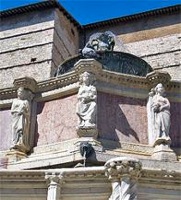
Water spills over from upper into the middle basin, which is formed from 24 slabs of pink stone from Bettona with marble figures at the junctions. Inscriptions above identify the figures. The three figures illustrated here (which face Corso Vannucci) personify Perugia and her dependent territories (see below).
The long inscription made up of five hexameters runs along the lower cornice. This identifies the roles of Fra. Bevignate, Nicolò and Giovanni Pisani, and Boninsegna. The relevant sections translate:
-
✴City of Perugia, rejoice and remember as your father
-
good Fra. Bevignate, devoted to every wise undertaking.
-
He is the builder of this work, he directed all things.
-
We should praise him with the sweet name of [St] Benedict.
-
Capable of order, he has given us this work and is pleased.
-
✴These are the names of the excellent sculptors of the fountain:
-
Nicola, famous in this art, is appreciated in every work.
-
He is the flower of sculptors and most pleasing among the good.
-
He is the father, and the other is the most beloved son
-
.... who is named Giovanni.
-
Pisans by birth, may they long be healthy.
-
✴We know which celebrated mind brought in the waters:
-
he who ... is known as Boninsegna.
-
He executed the work and made all the piping.
-
He was born in Venice and is beloved by the Perugians.
The poem also records the completion of the work in 1278, at the time of Pope Nicholas III and the Emperor Rudolf I.
Lower Basin
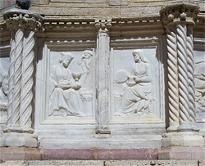
Twelve spouts in the lower cornice of the middle basin conduct water into the larger lower basin, which is made of Carrara marble and decorated with 25 pairs of marble reliefs. Again, the subject of each is identified by a Latin inscription. The pair of reliefs illustrated here belongs to a series on the labours of the months: these two represent January and February.
Recent History

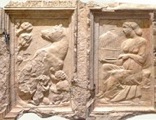
Rome Romulus and Remus suckled by a wolf
and their mother, Rea Silvia
The personification of Rome (on the middle basin, facing Palazzo Vescovile to the west) and the related pair of reliefs of Romulus and Remus and their mother Rea Silvia (on the lower basin) spoke of Perugia's allegiance to the papacy. These panels were damaged in the uprising of 1859 and replaced by copies during restoration in 1948: the originals (illustrated here) are in the Galleria Nazionale.
Other Work in Perugia by Giovanni Pisano
Monument to Pope Martin IV
According to Giorgio Vasari, “Pope Urban IV having died ... in Perugia, a summons was sent to Giovanni, who, having gone there, made a tomb of marble for that Pontiff, which, together with that of Pope Martin IV, was afterwards thrown to the ground when the people of Perugia enlarged their Vescovado [Episcopal Palace], in a manner that there are seen only a few fragments of it scattered throughout the church”. In fact, Urban IV died in 1264, some 10 years before the first recorded work by Giovanni Pisano. It is possible, however, that he worked on the monument to Martin IV (died 1285). (Both of these monuments were in the old Duomo).
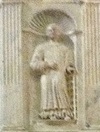

The reliefs of SS Lawrence and Herculanus reused on the pulpits (1519) in the present church might have belonged to this monument.
Work in San Domenico
Giorgio Vasari also attributed three works at San Domenico to Giovanni Pisano:
-
✴The first in the monument to Pope Benedict IX: according to Vasari, “Pope Benedict IX having died in Perugia, a summons was sent to Giovanni, who ... made a tomb of marble for that Pontiff in [San Domenico Vecchio]. Few if any scholars accept the attribution, but a number subscribe to the implied dating to a time before ca. 1315, when Giovanni Pisano died.
-
✴The second was “the tomb of Messer Nicolò Guidalotti of Perugia, Bishop of Recanati, who was founder of the Sapienza Nuova”. In fact, he is referring to the tomb of Benedetto Guidalotti, who in 1429, some 200 years after Giovanni’s own death.
-
✴The third was in the new church of San Domenico, where “he executed the central nave, which was designed by him with much better method than the remainder of the church had been; for on one side it leans and threatens to fall down, by reason of having been badly founded”.
Head of a young man (early 14th century)
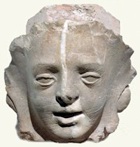
Todi
Madonna and Child and an angel with a bishop (ca. 1296)
These two sculptural groups in the crypt of the Duomo came from funerary monument of Bishop Nicholas II, who was buried in the Duomo in 1296. [Original location and disposition] In the second group, the solicitous angel has his arm around the bishop’s shoulders. The works are of high quality and are attributed to an Orvietan sculptor or sometimes to Giovanni Pisano or one of his followers. All the figures are damaged, and only the middle portion of the Christ Child survives.
A sculpted figure of a female saint nearby, which is of lower quality, has been attributed to Rubeus. It is possible that it came from the same monument.



